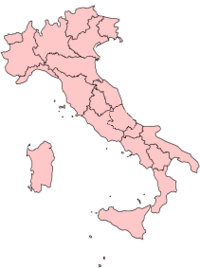Lampedusa

| |
| Comune di Lampedusa e Linosa | |
|---|---|
| Name | Lampedusa |
| Region | Sicily |
| Province | Agrigento (AG) |
| Altitude | 16 |
| Area city proper | 25.48 |
| Population as of | |
| Population density | 6,025 |
| Population density metric | 230 |
| Time zone | CET, UTC+1 |
| Frazioni | Lampedusa, Linosa, Cala Creta, Cala Francese, Grecale, Terranova |
| Telephone | 0922 |
| Postal code | 92010 |
| Gentilic | Lampedusani, Linosani |
| Saint | Madonna di Porto Salvo |
| Day | September 22 |
| Mayor | Sebastiano Bruno Siracusa (since May 28, 2005) |
| Website | www.isoladilampedusa.it |
The Mediterranean island of Lampedusa Template:In it is the largest of the Pelagie Islands and is situated 205 km from Sicily and 113 km from Tunisia. Its population subsists on fishing, agriculture and tourism.
The comune of Lampedusa, correctly called Lampedusa e Linosa, also includes the smaller islands of Linosa and Lampione; the former is inhabited but the latter just hosts an automatic lighthouse.
Geography
Politically and administratively Lampedusa is part of Italy, but geologically it belongs to Africa since the sea between the two is no deeper than 120 meters. Lampedusa is an arid island, with no sources of water other than irregular rainfall. The fauna and flora of Lampedusa are similar to those of North Africa.
The so-called Isola dei Conigli ("Rabbits Island") is one of the few reproduction sites in the Mediterranean for the Loggerhead Sea Turtle. The beach and the neighbouring island are part of a Natural Preserve: here the famous singer-songwriter Domenico Modugno spent his vacations, and also died in 1994. Next to Parise Cape is a small beach accessible only by sea, through a low grotto.
Other species living along the island's coast include mantas and dolphins
History
Historically, Lampedusa was a landing place and a maritime base for the ancient Phoenicians, Greeks, Romans and Arabs. The Romans established a plant for the production of the prized fish sauce known as garum. As a result of pirate attacks by the Arabs, the island became uninhabited.
The first prince of Lampedusa and Linosa was Giulio Tomasi, ancestor of the famous writer Giuseppe Tomasi di Lampedusa, who received the title from Charles II of Spain in 1630. A century later the Tomasi family began a program of resettlment.
In 1860 the island became part of the new Kingdom of Italy, but the new government limited its activities there to building a penal colony.
During World War II, the island was captured by the British Forces in Operation Corkscrew, as an immediate precursor to the Allied invasion of Sicily.
The first telephone connection with Sicily was installed only in the 1960s. In the same decade an electric power station was built and the western part of the island became a NATO base.
On April 15, 1986, Libya fired two or three Scuds at the U.S. Coast Guard navigation station on the Italian island, in retaliation for the American bombing of Tripoli and Benghazi.
Recently Lampedusa has made international news as a prime transit site for asylum seekers hoping to enter Europe from Africa, the Middle East and Asia. Recent agreements made between the Libyan and Italian governments have seen the deportation of many such migrants from Lampedusa to Libya.
Transportation
The island of Lampedusa is connected to Sicily by a ferry service with the seaport of Porto Empedocle, near Agrigento. Lampedusa has also a small national airport which carries out service mainly during the summer period.
Culture
The movie Respiro (2002) by the Italian movie director Emanuele Crialese was filmed on Lampedusa.
See also
External links
- BBC News – Italy Deports Island Immigrants – Covers the changing face of immigration in 2004
- Official site

